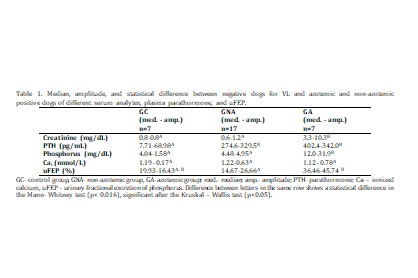Calcium, phosphorus, urinary fractional excretion of phosphorus and parathormone in dogs with visceral leishmaniasis
DOI:
https://doi.org/10.21708/avb.2020.14.3.9154Abstract
The kidneys perform an essential role in the regulation of serum phosphorus concentration. In visceral leishmaniasis (VL), the decline of the glomerular filtration rate leads to hyperphosphatemia, whose primary consequence is the development of secondary renal hyperparathyroidism. This study aimed to determine the concentration of serum phosphorus, ionized calcium (Cai), urinary fractional excretion of phosphorus (uFEP), and parathormone (PTH) in azotemic and non-azotemic dogs with VL and evaluate the uFEP as a marker of secondary renal hyperparathyroidism. The study comprised 31 dogs, divided into 24 sick animals and 07 healthy animals used as a control group (GC). The sick animals were classified into groups as azotemic (GA) and non-azotemic (GNA). The serum levels of phosphorus, creatinine, Cai, and the plasma levels of PTH were measured and compared between groups. The uFEP was calculated using values of serum and urinary levels of phosphorus and creatinine. The Kruskal-Wallis test with a 0.05 significance level was used, followed by the Mann-Whitney test as a post hoc test, with a 0.016 significance level. The levels of serum phosphorus were higher in the GA group, whereas for the PTH, the GNA and GA groups demonstrated high values compared to the GC. The uFEP was significantly higher in the GA when compared to the GNA, although there was no statistical difference between the GC and the GNA. The uFEP showed to be a late marker of chronic kidney disease and secondary hyperparathyroidism in dogs with visceral leishmaniasis.
Downloads

Downloads
Published
Issue
Section
License
Autores que publicam na Acta Veterinaria Brasilica concordam com os seguintes termos: a) Autores mantém os direitos autorais e concedem à revista o direito de primeira publicação, com o trabalho simultaneamente licenciado sob a Licença Creative Commons Attribution que permite o compartilhamento do trabalho com reconhecimento da autoria e publicação inicial nesta revista. b) Autores têm autorização para assumir contratos adicionais separadamente, para distribuição não-exclusiva da versão do trabalho publicada nesta revista (ex.: publicar em repositório institucional ou como capítulo de livro), com reconhecimento de autoria e publicação inicial nesta revista. c) Autores têm permissão e são estimulados a publicar e distribuir seu trabalho online (ex.: em repositórios institucionais ou na sua página pessoal) a qualquer ponto antes ou durante o processo editorial, já que isso pode gerar alterações produtivas, bem como aumentar o impacto e a citação do trabalho publicado (Veja O Efeito do Acesso Livre).


 Esta obra está licenciada com uma Licença
Esta obra está licenciada com uma Licença 